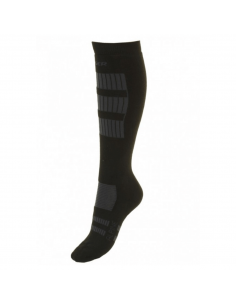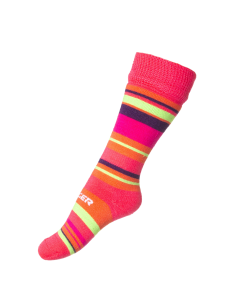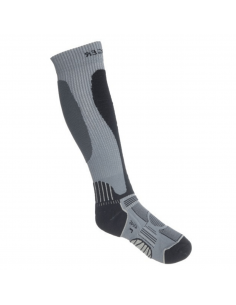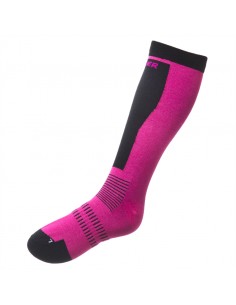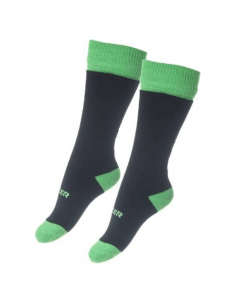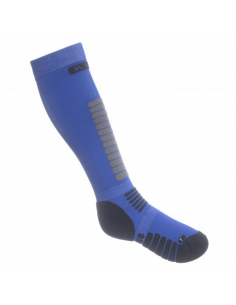Varer af mærket Seger
Seger, at the forefront of knitting since 1947.
MereHistory
Röshult/Gällstad in 1947. Gunnar Segerqvist was a 16-year old boy, determined to create his own destiny. Since the knitting tradition of Gunnar’s native place was strong, the choice of business came naturally. He cleared his parents’ old woodshed, learnt how to work a knitting machine and opened his business. The range of the newly established Gunnar Segerqvist Hemstickeri consisted of socks, football socks and long ladies’ and children’s socks. When the bike bag was full, Gunnar got on his grandfather’s old bike and set out. The career as a pedlar had started.
At that time, more than fifty years ago, the key words that have made the company what it is today, were created. From the start Service, Quality, Development, Function and Communication were important, even though the company was so much smaller then.
The business flourished. A few years after the establishment, the bike was traded for a brand new Renault station wagon that cost sek 4 800. Now Gunnar could expand his sales area and headed towards Skaraborg, Värmland and Dalarna as well as east towards Småland. He kept his bike attached to the car, since there were still customers that could not be reached by cars. That is what we call service…
It was a busy time for Gunnar – the development was swift. The house-to-house peddling became “unpackings” where customers were greeted in rented community centres. The suppliers were by now the dominating target group. The days were filled with sales trips, the nights with knitting and the weekends with the newly established mail order business. The woodshed started to feel crowded.
In 1963, the time had come to leave home. New, modern automatic knitting machines were purchased and they demanded more space. Newly built premises, of 200 m2 offered space to grow in. One thought. In 1970, the factory had to be enlarged to 1 000 m2.
In 1985, something could have meant the end of the company happened. The entire factory burned down, and all the machines with it. A hard blow of course, but one never hesitated to rebuild it. The day after the fire, the work of making orders to all tricot factories in Gällstad started. Everyone joined in wholeheartedly, as proof of the famous ”Gällstad spirit”. A total of 19 factories, not only in Gällstad, were engaged during the rebuilding of Seger’s new factory.
In april 1986, the time had come to open the new factory. It was twice as large as the old one and had an ultra modern, computerised machinery. That dark cloud turned out to have a silver lining after all.
Seger Today
The business is still run from Gällstad – Sweden’s tricot centre. The woodshed has been traded for functional premises of 6 500 m2, the first knitting machine has developed into an ultra modern machinery and, last but not least, the company that started with one person now has 80 efficient employees.
A part of New Wave Group AB since 2001, www.nwg.se
Seger is still the leading supplier of technically knitted socks and caps. The rewarding co-operation with successful athletes continues and is being further developed.
The key words and set of values formed in 1947 are very much current today. The demands are higher and in many ways different today, but the fundamental idea is still the same. The striving to always be leading when it comes to Service, Quality, Development, Function and Communication leavens every aspect of the business.
SEGER - WITH IT'S ORIGIN IN THE WORLD OF SPORTS
Throughout the years, the co-operation with successful athletes has played an important part in Seger’s business philosophy. As the Swedish athletic successes have been given more and more space in the media, the co-operation has contributed to that Seger is a well-known, strong trademark outside Sweden as well today. A few examples of early connections between famous athletes or national teams and Seger are:
- 1959. Ingemar Johansson knocked Floyd Pattersson out and became the world champion of heavyweight boxing.
- Seger created ”Ingemarsmössan” (“the Ingemar cap”), which was a popular winter product for several years.
- 1960. Sixten Jernberg hurried along the ski track and felt mighty mad. Ski socks, he roared, should cover the knees, damn it! (At that time, a skier’s outfit consisted of knee-long trousers and socks.)
Gunnar listened to Jernberg’s words and knitted socks that suited him. Jernberg answered by becoming a seller of Seger’s socks. - 1968. Janne Lundkvist var framgångsrik i tennis.
Segerstrumpor för tennis utvecklades. - 1969. Ove Grahn became a professional football player in the Grasshoppers.
He, as well as the Swedish national football team, played in Seger’s football socks. - 1972. The summer Olympics in Munich.
The entire Swedish troop once again wore Seger socks. - 1974. Ingemar Stenmark wins his first slalom world cup, in Madonna di Campiglio.
”Stenmarksmössan” (“the Stenmark cap”) was suddenly worn by everyone and it became a huge product for Seger. - 1981. Tre kronor (the Swedish national ice-hockey team) receives a medal in the ice-hockey world championship in Gothenburg.
Seger can be seen in the rink as well.
Our current partners are presented under sponsorships.

